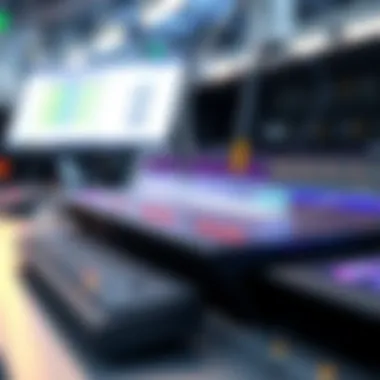Exploring Qiagen Pyrosequencing: Principles and Advances


Article Overview
Purpose of the Article
This article serves to detail the innovative technique known as Qiagen pyrosequencing, a groundbreaking method that integrates sequencing with polymerase chain reaction (PCR) in one streamlined process. The goal here is to break down the principles behind this technology, its numerous applications, and the advancements in the field, making it easier for researchers and professionals to grasp its significance in scientific exploration.
Relevance to Multiple Disciplines
The impact of Qiagen pyrosequencing extends well beyond merely genomic sequencing. It's a valuable tool used in diverse fields such as molecular biology, genetics, and even clinical diagnostics. Its efficiency allows for rapid data generation, essential for various research initiatives, including those related to personalized medicine, infectious disease detection, and evolutionary studies.
Research Background
Historical Context
The evolution of sequencing methods marks a considerable leap in biological sciences. In the early days, Sanger sequencing paved the way for genome mapping, which was time-consuming and labor-intensive. As technologies progressed, new methods like pyrosequencing emerged in the late 1990s, combining high throughput capabilities with simplicity. Qiagen’s adaptation of this method reflects an ongoing trend towards improved efficiency in molecular biology.
Key Concepts and Definitions
To effectively understand Qiagen pyrosequencing, it's essential to grasp some fundamental concepts. The term pyrosequencing refers to a sequencing method that relies on the detection of pyrophosphate released during nucleotide incorporation. In essence, as DNA polymerase synthesizes new DNA strands, it releases a burst of energy that is converted into a detectable signal. The process eliminates the need for gel electrophoresis, allowing for quicker and more accurate results.
"Pyrosequencing significantly advances the speed and accuracy of nucleotide sequencing, facilitating numerous research applications."
"Pyrosequencing significantly advances the speed and accuracy of nucleotide sequencing, facilitating numerous research applications."
A few key terms include:
- Nucleotide: The basic building block of DNA and RNA.
- Polymerase Chain Reaction (PCR): A technique used to amplify DNA sequences, enabling further analysis.
- High Throughput: The ability to process large amounts of data efficiently.
Through this article, the focus will be on elucidating not only the operational mechanics of Qiagen pyrosequencing but also its current applications and future potential within varied fields of study, thereby aiding professionals and educators in effectively leveraging this technique.
For more on sequencing technologies, check out resources like Wikipedia and Britannica, which offer a broad overview of the developments in this area.
Prologue to Pyrosequencing
Pyrosequencing stands out as a technology that merges DNA sequencing and the polymerase chain reaction (PCR) into a streamlined process, crucial for researchers and practitioners in molecular biology. Its unique approach allows for efficient and accurate DNA sequencing, which is vital in numerous fields, including genomics, clinical diagnostics, and microbial sequencing.
Unlike older sequencing methods, pyrosequencing doesn't just read the sequence; it visually monitors the synthesis of DNA in real-time. This is akin to watching the building blocks of life assemble before your eyes, which is a powerful image when thinking about the implications for research and health.
The significance of understanding pyrosequencing lies in its impact on the speed and accuracy of genetic analysis. As studies advance and precision becomes crucial for understanding complex biological systems, techniques like pyrosequencing provide tools that can meet the demands of modern science. Knowing its principles equips researchers with the knowledge they need to apply this technology in innovative ways to address pressing questions in health and disease.
Defining Pyrosequencing
Pyrosequencing is a sequencing method that relies on the detection of light released during the nucleotide incorporation process. Essentially, it allows scientists to determine the order of nucleotides in a DNA strand by simultaneously measuring the generation of light, a result of the release of pyrophosphate. When incorporated into a growing DNA strand, the release of this pyrophosphate triggers a cascade of reactions, culminating in light emission, which is detectable and quantifiable.
This technique differentiates itself from traditional sequencing methods by its speed and scalability. Because it can generate data in real-time, it simplifies the workflow often required in genetic analysis. The combination of PCR and sequencing in one step minimizes errors and time, making it a superior choice in many applications.
Historical Development
The roots of pyrosequencing trace back to scientific innovations in the late 20th century. It emerged from the need for faster, more efficient methods for sequencing DNA, building upon the foundational work of Sanger and others who established earlier sequencing methods.
In the late 1990s, researchers like Pyrosequencing AB started developing protocols that would lead to the commercialization of the technology. The introduction of the first pyrosequencing platforms in the early 2000s marked a turning point in the field of genomics. These devices made it possible for labs around the world to access a reliable method for sequencing that was previously reserved for only the most well-funded institutions.
As this technology progressed, it began to be integrated into broader genomic studies. The Human Genome Project, completed in 2003, served as a catalyst for the adoption of pyrosequencing across many research areas. Overall, understanding this historical context helps capture why pyrosequencing is now regarded as a vital tool in molecular biology and genetic research.
Principles of Qiagen Pyrosequencing
Understanding the principles of Qiagen pyrosequencing is integral to grasping its place in the realm of sequencing technologies. This technique, which marries the concepts of DNA sequencing and polymerase chain reaction, offers a fresh perspective on how genetic information can be decoded efficiently and effectively. With the growing need for precision in genomic analysis, diving into these principles sheds light on its practical applications and the benefits it brings to researchers and clinicians alike.
Sequencing Mechanism
At the heart of Qiagen pyrosequencing lies a distinctive sequencing mechanism that sets it apart from other methods. Traditional sequencing techniques often involve laborious processes that can be time-consuming and error-prone. However, pyrosequencing spruces up the workflow significantly.
The method works on the principle of detecting the release of pyrophosphate during nucleotide incorporation. When a nucleotide is added to a growing DNA strand, pyrophosphate is released, triggering an enzymatic cascade that produces light. This light is captured and quantified, offering immediate feedback on which nucleotide has been incorporated. The sequential addition of nucleotides enables the rapid determination of the DNA sequence.
This real-time detection mechanism makes pyrosequencing an attractive option for applications requiring quick results, such as clinical diagnostics or real-time monitoring of genetic changes. Essentially, the incorporation of light emission not only paces up the sequencing process but also enhances accuracy—largely due to its ability to avoid some common pitfalls that other sequencing methods encounter.
Polymerase Chain Reaction Integration
One of the standout features of Qiagen pyrosequencing is its seamless integration with the polymerase chain reaction (PCR). PCR has revolutionized molecular biology by allowing for the amplification of specific DNA sequences, making it possible to work with minimal amounts of starting material. The synergy created by hybridizing these two techniques broadens the utility of pyrosequencing in varied scenarios.
In practice, the combination means that after amplification of the target DNA, the sample can proceed directly to pyrosequencing without the need for intermediate steps like purification—this streamlines the entire workflow. Moreover, this integration paves the way for greater sensitivity and specificity, which is critical when dealing with complex samples, especially in clinical settings. By reducing the risk of contamination and loss of sample quality, researchers can be more confident in the results derived from pyrosequencing.


Real-time Monitoring
A defining aspect of Qiagen pyrosequencing is its real-time monitoring capabilities. Unlike traditional methods where data collection happens post-sequencing, this method provides insights as the sequencing runs unfold. This characteristic is particularly beneficial when monitoring dynamic biological processes, such as microbial growth or mutation identification.
Real-time data generation allows investigators to observe changes in nucleotide sequences almost instantaneously, facilitating quicker interpretations of results. This can be crucial in fast-paced environments like clinical diagnostics where timely decision-making can impact patient outcomes.
Furthermore, real-time monitoring aids in error detection—issues with the sequencing process can become apparent immediately, allowing for troubleshooting or adjustments to be made on-the-fly. Not only does this improve the reliability of the sequencing results, but it also enhances the overall efficiency of the workflow.
"The ability for real-time monitoring transforms the atmosphere of laboratory work, placing an emphasis on immediacy in genetic analysis that was previously unattainable."
"The ability for real-time monitoring transforms the atmosphere of laboratory work, placing an emphasis on immediacy in genetic analysis that was previously unattainable."
In summary, the principles driving Qiagen pyrosequencing not only present a technological advancement, but they also set the stage for numerous practical applications across disciplines like genomics, diagnostics, and biotechnology. By understanding its sequencing mechanism, the integration with PCR, and the benefits of real-time monitoring, it becomes evident how Qiagen pyrosequencing continues to influence the landscape of genetic research.
Technical Methodology
The technical methodology of Qiagen pyrosequencing is where the rubber meets the road in understanding this sophisticated process. At the heart of any sequencing technique lies proper sample preparation, detailed sequencing steps, and robust data analysis. Each of these components plays a vital role in ensuring accuracy and reliability, making the technical methodology the backbone of successful pyrosequencing.
One cannot underscore enough the importance of proper preparation and execution in obtaining high-quality, usable results. Without a solid methodology, even the most advanced sequencing techniques may falter. In this section, we will dissect the critical aspects of the technical methodology, spotlighting the unique samples, precise steps, and effective data interpretation mechanisms that characterize Qiagen pyrosequencing.
Sample Preparation Techniques
Sample preparation serves as the foundation of any sequencing endeavor. In the context of Qiagen pyrosequencing, this stage is paramount for ensuring optimal results. The first step involves extracting DNA or RNA from cells or tissues, which can be as straightforward as using Qiagen's own extraction kits designed for specific sample types.
Following extraction, quantification is crucial. It's important to measure the concentration and purity of the nucleic acids obtained. This is typically accomplished using a spectrophotometer or fluorometer. An inadequate quality of the starting material can lead to subpar sequencing results. Therefore, diligence at this stage pays dividends down the line.
Furthermore, one must consider the choice of primers. Primers should be designed to bind specifically to the target DNA sequences. Ineffective primer design can cause bias or failure in amplification. It might be beneficial to run a few test amplifications before finalizing the primers used for sequencing to identify the most effective set for the target.
DNA Sequencing Steps
The sequencing process in Qiagen pyrosequencing follows a well-structured workflow that enhances both efficiency and reliability. The steps involved are methodical and designed to minimize potential errors.
- Amplification of DNA: This step involves polymerase chain reaction (PCR) to generate enough template DNA for sequencing. The inclusion of a tagged primer is essential here, as it facilitates the pyrosequencing process.
- Pyrosequencing Reaction: Once amplification is complete, the reaction takes place within a specialized system where the actual sequencing occurs. As nucleotides are incorporated into the growing DNA strand, light is emitted, correlating with the sequence of bases added. The intensity and timing of light changes are captured by the system.
- Real-Time Monitoring: Throughout the sequencing process, real-time monitoring allows researchers to observe the progress as sequences emerge. This immediate feedback can be instrumental in detecting anomalies early on.
Each step needs to be executed with care to ensure that the final sequence data generated is of high quality.
Data Analysis and Interpretation
Data analysis is the final frontier in the pyrosequencing workflow. After the sequences are generated, it becomes crucial to process this information accurately to derive meaningful insights. The quality of the data generated is typically assessed through algorithms which help filter out any low-quality reads, often seen at the ends of sequences.
Once cleaned up, the data can be aligned with reference sequences or databases to identify variants. This alignment can highlight differences in sequences, allowing for further biological interpretations.
- Visualization Tools: Often, researchers employ visualization software to better understand sequence data, enabling them to spot trends, mutations, or unique attributes of a given organism.
- Statistical Analysis: Depending on the application, statistical measures may be applied to the results to determine significance or to assess the reliability of the findings.
In sum, the technical methodology in Qiagen pyrosequencing blends analytical prowess with structured techniques to transform raw biological samples into actionable insights, showcasing its indispensable value in the field of genomics and molecular biology.
Applications of Qiagen Pyrosequencing
Qiagen Pyrosequencing is making waves across various fields, and understanding its applications is key to appreciate its significance. From unraveling the complexities of genomics to pinpointing genetic disorders in clinical settings, this technology is opening doors to possibilities previously thought to be out of reach. In this section, we will explore how Qiagen Pyrosequencing features prominently in genomics research, clinical diagnostics, and microbial sequencing, shedding light on its importance and benefits.
Genomics Research
Genomics research has greatly benefited from the advancements brought by Qiagen Pyrosequencing. This method allows researchers to obtain high-quality sequence data rapidly and efficiently. One of the standout elements of this sequencing technique is its capability to produce real-time results, enabling scientists to make timely decisions. The high throughput nature of Qiagen Pyrosequencing is another feather in its cap, as researchers can tackle large genomes within a fraction of the time required by traditional methods.
"With Qiagen Pyrosequencing, the realm of genomic exploration is not just a dream; it's a reality."
"With Qiagen Pyrosequencing, the realm of genomic exploration is not just a dream; it's a reality."
Key applications in genomics include:
- SNP Discovery: Identifying single nucleotide polymorphisms is pivotal in understanding genetic variation, and Pyrosequencing allows for quick detection across various populations.
- Whole Genome Sequencing: This application is vital for evolutionary studies, helping to unveil genetic similarities and differences between species.
- Epigenetics: The technology can also shed light on methylation patterns, which have implications in gene expression.
In summary, Qiagen Pyrosequencing is crucial for researchers digging into the depths of genomics, providing insights that can lead to breakthrough discoveries.
Clinical Diagnostics
In the realm of clinical diagnostics, Qiagen Pyrosequencing is stepping into the spotlight. Its precision and speed are invaluable for diagnosing various genetic conditions and infectious diseases. In a world where rapid results often mean better patient outcomes, this technology shines bright.
The applications here are diverse:
- Cancer Genotyping: The ability to detect mutations in cancer-related genes can guide treatment decisions, which can be lifesaving.
- Infectious Disease Testing: Detecting pathogens quickly ensures that appropriate therapies can begin without delay. Its high accuracy reduces the chances of false positives that can lead to misdiagnosis.
- Pharmacogenomics: Understanding how patients metabolize drugs at the genetic level can inform treatment plans, especially in personalized medicine initiatives.


This technology doesn't just stand out for its accuracy; it also accommodates a broad range of samples, whether from blood or tissue, making it flexible for clinic-based applications.
Microbial Sequencing
When it comes to microbial sequencing, Qiagen Pyrosequencing offers a robust tool for identifying and characterizing microorganisms. This application is particularly valuable in environmental microbiology, clinical settings, and food safety.
Some notable uses include:
- Pathogen Identification: Rapid and precise identification of microbial pathogens is essential in public health. Pyrosequencing ensures timely intervention, especially during outbreaks.
- Metagenomics: Researchers can explore community compositions in various habitats, from oceans to the human gut, facilitating a better understanding of microbial diversity and ecosystem dynamics.
- Antibiotic Resistance Studies: Identifying genetic markers linked to resistance can help combat the growing issue of drug-resistant infections.
The versatility and efficiency of Qiagen Pyrosequencing mark a new era in microbial genomics, enabling scientists to explore previously uncharted territories of life forms.
Comparative Analysis
In the realm of genetic sequencing, performing a comparative analysis of different techniques becomes paramount. This section provides insights into the contrasts between pyrosequencing and traditional sequencing methods, shedding light on their unique benefits and limitations. Understanding these differences not only enhances scientific literacy but also cultivates informed decision-making in various research and clinical applications.
Pyrosequencing vs. Traditional Sequencing Techniques
When comparing pyrosequencing to traditional techniques, two major methods come to mind: Sanger sequencing and next-generation sequencing (NGS).
Pyrosequencing operates on the principle of detecting the release of pyrophosphate during nucleotide incorporation, which stands apart from Sanger's reliance on chain termination and NGS's massively parallel sequencing approach. Here's how they stack up against each other:
- Speed and Throughput: Pyrosequencing provides rapid results, often completing analyses in a matter of hours compared to Sanger sequencing, which can take days. While NGS excels in high-throughput capabilities, pyrosequencing's quick turnaround makes it suitable for real-time applications.
- Cost Effectiveness: Traditional Sanger sequencing can become pricey, especially for larger projects, while pyrosequencing offers a more affordable option for small-scale experiments. NGS, while cheaper per base, involves higher initial costs for the platform.
- Read Lengths: Sanger sequencing offers longer reads, facilitating easier assembly of complex genomes. However, pyrosequencing typically generates shorter sequences, which may sometimes challenge the resolution of intricate genomic regions. NGS, on the other hand, manages varied read lengths effectively based on the specific technology used.
- Applications: Each method finds its niche. Pyrosequencing shines in areas requiring quick results such as clinical diagnostics and targeted resequencing. Traditional Sanger sequencing remains a gold standard for verification of sequences, especially in small sequencing efforts. NGS dominates in large-scale whole-genome sequencing and metagenomic studies.
In summary, choosing between pyrosequencing and traditional approaches often hinges on project objectives, resource availability, and time constraints.
Efficiency and Accuracy Metrics
The efficiency and accuracy of pyrosequencing compared to traditional methods are critical metrics that impact its adoption. Key aspects include:
- Sensitivity: Pyrosequencing usually reveals a high degree of sensitivity, allowing for the identification of low-frequency variants within a sample. This advantage benefits applications such as cancer genomics, where minor mutations are significant.
- Error Rates: Each technique harbors its own error profile. Pyrosequencing, though generally accurate, is susceptible to homopolymeric regions, causing challenges in accurately interpreting sequences. This primes a careful evaluation against Sanger's low error rate in delivering precise assemblies. NGS can offer higher accuracy but requires robust bioinformatics to handle the sheer volume of data generated and to mitigate errors.
- Workflow Efficiency: Pyrosequencing integrates well with PCR, streamlining workflows by combining amplification with sequencing, which minimizes sample handling. Traditional methods often require more steps, making them prone to errors during sample transfers.
Ultimately, the choice of sequencing method might depend on the balancing act between accuracy, speed, and cost, considering these key metrics. An awareness of both techniques' strengths helps researchers and clinicians select the most suitable approach for their specific inquiries.
"Understanding the landscape of sequencing technology is essential as it influences experimental design and data interpretation in genomic analysis."
"Understanding the landscape of sequencing technology is essential as it influences experimental design and data interpretation in genomic analysis."
For further details on sequencing techniques and their applications, consider resources like Britannica or Wikipedia. These platforms provide further reading on the nuances of different sequencing methodologies.
Challenges in Pyrosequencing
The landscape of pyrosequencing is undeniably transformative, yet it doesn’t come without its fair share of hurdles. To really grasp the complexity of this technique, one must consider both its inherent limitations and the strategies adopted to navigate them. Understanding these challenges is crucial for researchers, as it illuminates the road ahead, emphasizing the importance of innovation and adaptation in this rapidly evolving field.
Limitations of the Technique
While pyrosequencing shines with its real-time monitoring and ability to produce accurate sequencing data, it encounters constraints that can hamper its application and effectiveness. Here are a few pivotal limitations:
- Short Read Lengths: The typical read lengths achieved through pyrosequencing are limited compared to traditional methods like Sanger sequencing. This can pose challenges in resolving complex genomic regions due to repetitive sequences.
- Cost Considerations: While the technology has become more accessible, the costs associated with the reagents and machinery can be a barrier, especially for smaller labs in developing regions.
- Single-Base Resolution Issues: Pyrosequencing can struggle with distinguishing between certain base pair configurations, which may result in ambiguity in the sequencing results, especially within homopolymeric regions.
A careful consideration of these limitations informs researchers about the suitability of pyrosequencing for their specific applications, which is essential for optimizing study designs.
Addressing Errors in Sequencing
Errors in sequencing can invite a whole host of problems, potentially skewing results and leading to incorrect interpretations. However, researchers have developed methodologies to tackle these challenges. Here are some strategies to minimize and address errors:
- Error-Correction Algorithms: Advanced computational techniques can be employed to identify and correct errors that may have occurred during sequencing. This involves using reference sequences to reconcile discrepancies.
- Increasing Coverage Depth: By ensuring that multiple reads cover the same region of interest, the likelihood of erroneous data can be substantially reduced. Higher coverage helps in averaging out potential errors across reads.
- Quality Control Protocols: Implementing stringent quality control measures during the sample preparation and sequencing stages can catch problems early on. This includes checking for contamination and ensuring the integrity of the DNA samples.
"Adapting to potential errors can be the difference between clear insights and confusing data—precision is key in genomic studies that demand a high level of accuracy."
"Adapting to potential errors can be the difference between clear insights and confusing data—precision is key in genomic studies that demand a high level of accuracy."
Recent Advancements
Recent advancements in Qiagen pyrosequencing highlight the evolution of this technique in the realm of genomics and molecular biology. As technology progresses, the integration of new tools, improvements in speed, accuracy, and user-friendliness, all create a thriving landscape for researchers and practitioners in this field.
Technological Innovations in Pyrosequencing
The development of innovative tools has significantly enhanced the capabilities of Qiagen pyrosequencing. One notable advancement is the adaptation of high-throughput platforms. These systems allow researchers to process multiple samples simultaneously, saving both time and resources. The implementation of automated liquid handling systems also reduces the risk of human error, thereby increasing the overall reliability of results.
Moreover, advancements in optics and detection methods have bolstered the sensitivity of pyrosequencing. New chemistries have been formulated to improve signal intensity during the sequencing process, which ensures better data quality.


- Improved Reagents: Modern reagents are designed to work more efficiently with less interference, promoting more accurate readings.
- Data Capture Techniques: New imaging technologies enable higher resolution data capture, providing clearer insights into sequencing results.
With these technological innovations, Qiagen pyrosequencing is paving the way for more detailed genomic studies and enhancing our capacity to explore complex genetic information.
Integration with Next-Generation Sequencing
The integration of Qiagen pyrosequencing with Next-Generation Sequencing (NGS) marks an essential turn in genomic research and diagnostics. NGS involves massively parallel sequencing, which accelerates the process of reading genomes manifold. By incorporating pyrosequencing into NGS workflows, researchers can capitalize on the strengths of both methods—speed and accuracy.
This hybrid approach allows for rapid identification of genetic variants, which is particularly beneficial for clinical diagnostics. Geneticists can swiftly analyze mutations that might indicate disease susceptibility or resistance. Additionally, this synergy enhances capabilities in fields such as personalized medicine, where understanding individual genetic makeup is crucial.
The merger of these technologies affords researchers:
- Flexibility in Analysis: It allows stakeholders to choose between different sequencing depths depending on study design.
- Cost-effectiveness: Researchers can optimize their resources by utilizing both methods for complementary purposes.
- Access to Broad Applications: From cancer genomics to infectious disease research, the collaboration opens numerous avenues for investigation and discovery.
In summary, advancements in Qiagen pyrosequencing are vital, pushing the boundaries of what's possible in genetic research. The emphasis on incorporating novel technologies and integrating with NGS reflects a concerted effort to refine the sequencing landscape, making it increasingly accessible and applicable across various scientific fields.
Future Trends in Pyrosequencing
As we look towards the horizon of biotechnological advancements, the realm of pyrosequencing stands at a pivotal crossroad. This technique, which fuses sequencing technology with polymerase chain reaction capabilities, has already transformed how we engage with genomics. Yet, the future holds even greater possibilities. Understanding these trends is paramount, not just for those who are directly involved in the field, but also for educators, researchers, and clinicians who rely on the ever-evolving landscape of molecular biology.
Expansion in Clinical Applications
The clinical arena is increasingly recognizing the value of Qiagen pyrosequencing. One major trend is its integration into genetic testing for various disorders. As healthcare leans more toward proactive rather than reactive measures, pyrosequencing provides a swift and accurate method to identify genetic variants associated with hereditary conditions.
A notable example includes:
- Oncology: It can be employed to detect mutations in tumor DNA, guiding targeted therapy decisions. This use is not just about identifying the presence of a mutation; it is about tailoring treatment plans for individual patients, thereby enhancing therapeutic efficacy.
- Infectious Diseases: Real-time monitoring of pathogen DNA helps clinicians adjust treatments based on the resistance profiles of infectious agents. The speed of pyrosequencing allows for a more dynamic response in treatment protocols, which can significantly improve patient outcomes.
The push for personalized medicine also drives this expansion. More healthcare institutions are adopting sequencer technology to assess patient susceptibility to various diseases, adapting prevention strategies accordingly.
Impact on Personalized Medicine
Personalized medicine, which aims to customize healthcare based on individual variability, is another area where pyrosequencing is making waves. The granularity provided by this technique allows for deep insights into an individual's genetic makeup. By understanding a patient’s unique genome, healthcare providers can make more informed decisions about prevention and treatment.
A few notable advantages include:
- Tailored Treatments: Medications can be prescribed based on specific genetic patterns. For instance, certain cancer therapies can be more effective in patients whose tumors exhibit particular genetic markers.
- Disease Risk Assessment: Pyrosequencing enables precise predictions regarding hereditary diseases, allowing individuals to modify lifestyle or treatment plans before any symptoms emerge, thus steering clear of potential health crises.
As these capabilities broaden, the ethical implications also deepen. There’s a pressing need for guidelines and regulations to manage the data obtained through pyrosequencing, ensuring patient privacy and data security while fully harnessing the technique's potential.
Beyond direct medical applications, the insights from pyrosequencing are fueling research into novel therapies and understanding disease mechanisms. As further advancements are made, it is essential that both the scientific community and healthcare stakeholders collaborate to navigate both the opportunities and challenges presented by these trends.
Ending
In wrapping up our exploration of Qiagen pyrosequencing, it becomes clear that this technique isn’t just a mere blip on the radar of genomic technologies; instead, it holds a significant place in both research and applied sciences. The combination of sequencing and PCR in one streamlined method offers unparalleled advantages in terms of speed and efficiency, setting a new standard in molecular biology.
Summary of Key Points
- Efficiency: Qiagen pyrosequencing accelerates the sequencing process, minimizing time from sample collection to data acquisition.
- Integration: The seamless integration of PCR within the pyrosequencing framework eliminates the need for separate laboratory workflows, enhancing overall practicality.
- Versatility: This technique finds its applications in genomics research, clinical diagnostics, and microbial sequencing, demonstrating a multifaceted utility across various fields.
- Real-Time Monitoring: Continuous observation of the sequencing process allows for immediate data analysis, leading to timely insights.
- Technological Advancements: Recent innovations have propelled Qiagen pyrosequencing to new heights, pushing boundaries in speed, accuracy, and even expanding its role in next-generation sequencing paradigms.
Final Thoughts on Future Directions
Looking ahead, the trajectory of Qiagen pyrosequencing indicates a growing convergence with personalized medicine. As genomic data becomes increasingly pivotal in tailoring treatments to individual patients, pyrosequencing can play an integral role in this transformation. Moreover, its reliability in clinical diagnostics positions it at the forefront of disease detection and monitoring.
Additionally, researchers plan to refine the technology further. Addressing existing limitations and enhancing data accuracy will be crucial for sustaining its relevance in a rapidly advancing field. Future integration with artificial intelligence and machine learning technologies could exponentially enhance the way we analyze and interpret complex genomic datasets, making the potential for breakthroughs far-reaching. In summary, embracing these advancements will not only cement Qiagen’s standing within the scientific community but also transform the landscape of molecular biology as a whole.
The potential of Qiagen pyrosequencing lies not only in its current applications but also in the innovations that future research will undoubtedly bring.
The potential of Qiagen pyrosequencing lies not only in its current applications but also in the innovations that future research will undoubtedly bring.
Importance of References
References in this article are specifically tailored to enrich understanding of Qiagen pyrosequencing. They provide a foundation from which researchers can appreciate the evolution of this technology, comprehend its operational mechanisms, and grasp the implications behind its applications. Without proper citations and references, the journey through the topic can lack credibility and depth.
"To know the way forward, one must first understand the path already traveled."
"To know the way forward, one must first understand the path already traveled."
Specific Elements and Benefits
Including well-chosen references has multiple advantages:
- Credibility: Referencing reputable sources builds trust in the narrative, allowing readers to feel more confident in the information presented.
- Contextualization: References help situate current advancements in the wider landscape of genetic sequencing, showing how Qiagen fits into the broader narrative of molecular biology.
- Accessibility to Knowledge: High-quality references encourage readers to dig deeper. Whether it's leading them to groundbreaking studies or providing evidence of successful applications, references enrich the reader’s overall experience.
Considerations about References
While choosing references, it’s vital to consider their relevance and recency. Technologies evolve at a fast-paced rate in scientific fields. Thus, including the latest articles, reviews, and studies ensures that the information is both current and applicable. For instance:
- Academic Journals: Sources such as Nature and Science yield peer-reviewed articles that often provide cutting-edge findings on sequencing technologies.
- Industry Publications: White papers from Qiagen and similar companies can offer insights directly from the source, revealing not only functionality but also future trajectories in technology.
- Educational Resources: Websites such as genomeweb.com or abbott.com contain rich content on genetic sequencing advancements, acting as a continuous reference point for professionals in the field.



